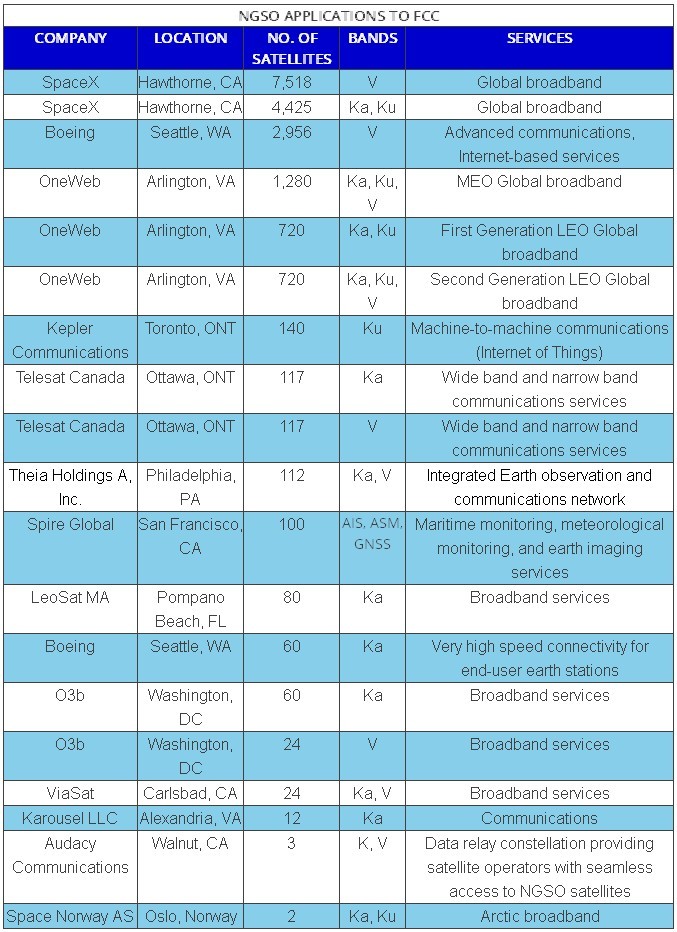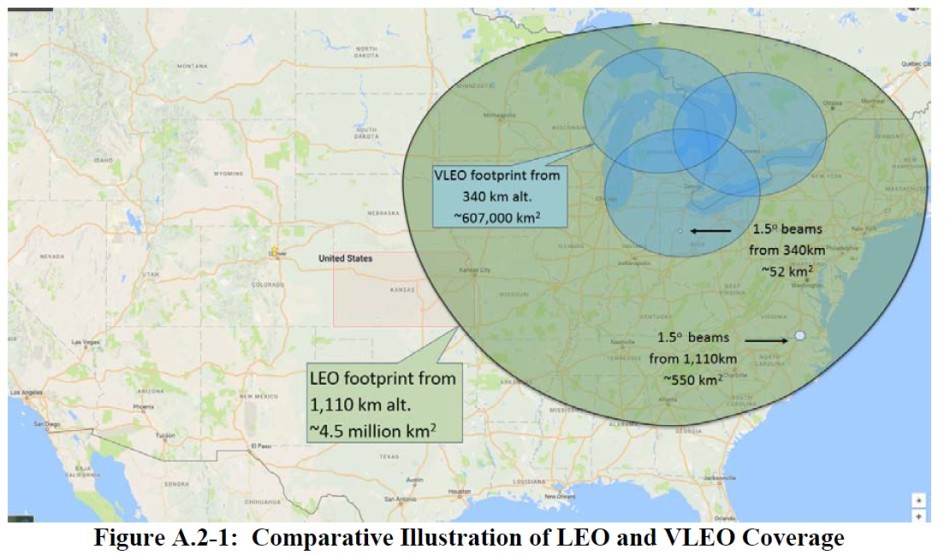In the new application from SpaceX, the number of distributing Internet satellites increased to 12,000
SpaceX seems set to create a sensation in the media every week. We did not have time to discuss plans to send two people to fly around the moon, as fresh, stunning news appeared - by the November application for 4425 satellites (with spare ones up to 4591) to distribute the global Internet, a new one was added to 7518, and the total number of satellites increased to 11,443, not including the backup ones. OneWeb, Telesat and other companies also made new applications and the total number of satellites planned for launching now amounts to a fantastic number of 18,470, which is 12 times more than the number of currently active satellites in orbit.

Kessler Syndrome, by A-Parrot / DeviantArt
According to Parabolic Arc , five companies filed new applications with the Federal Communications Commission (FCC): SpaceX, OneWeb, Telesat, O3b Networks, and Theia Holdings. The largest application for 7,518 additional satellites has been filed by SpaceX, OneWeb, in addition to the 720 already announced, another 2,000 satellites are about to be withdrawn, and the three remaining companies have already indicated modest numbers. Telesat Canada wants to add an additional 117 satellites, O3b - 24, and Theia Holdings did not change the number of satellites, but added new-range transmitters to them, and the same Boeing request was postponed by the FCC in November.
All new applications concern satellites that will operate in the V-band, until recently a rarely used communication frequency band, which is above the Ka-band and has frequencies from 40 to 75 GHz. Previously, only some military satellites used it - Milstar 1 and 2 had a communication channel at a frequency of 60 GHz, where there is a strong oxygen absorption line. This reduced the chances that the secret conversation of satellites could be heard from the earth’s surface.
The final table of applications to the Federal Communications Commission looks like this:

Table Doug Messier / Parabolic Arc
Simple arithmetic calculations showed that even supporting the original group of 4425 SpaceX satellites would require a revolution in the production of satellites and launch vehicles. On the new grouping calculations are obtained and completely absurd. If we take the life span specified in the application to be 5-7 years, then simply maintaining 1706-2388 satellites per year will be required to simply maintain the constellation of 11,943 satellites. Those. per day it will be necessary to produce 4.7-6.5 satellites and with something to put them into orbit. This is orders of magnitude (ie, hundreds and thousands) times more intensively than satellites are being built and are being displayed now.
The only rational hypothesis that can be invented by looking at how companies are flooded with FCC applications is an attempt to gain a foothold in the new market segment. Non-geostationary satellite communication systems are a new idea, and the V-band is still free, so companies can theoretically try to stake out the most convenient orbits and frequencies behind them. On the other hand, unlike the geostationary orbit, there is much more conditional space - in the range from 40 to 75 GHz you can fit many different projects at the same time, and placing satellite constellations on circular orbits of different heights will allow them to operate in parallel without interfering with each other. Also, against this hypothesis is the fact that companies continue to seriously argue that they will launch exactly the specified number of satellites. Oneweb for example just recentlysaid it raised $ 1.7 billion in investment and has already sold most of the source satellite resource.
It is very curious that SpaceX chose a very low orbit for the new constellation of satellites - only 340 km. This is below the ISS orbit, and at such an altitude the remnants of the atmosphere significantly slow down the satellites. But this removes the problem of space debris - in the SpaceX application it is written that after the end of its service life or the generation of fuel, the satellite will turn off the ion engine and turn around so as to slow down the maximum area. According to calculations, in this case it will descend from orbit within a few weeks. A broken satellite will slow down in a random position, which is less effective, but will stay in orbit not much longer.
Low orbit means that the satellite will be able to serve a smaller area of the earth's surface. Obviously, this is done on purpose - the application SpaceX said that the satellites at an altitude of about 1000 km will have to serve remote areas with low population density, and at an altitude of ~ 340 km - to provide high-speed connectivity

Work the corners and the size of area coverage of both systems, illustration SpaceX

Sites coverings with 1000 and 340 km, SpaceX illustration
Moreover, the application states that satellites at both altitudes will be able to interact in such a way as to provide the most flexible communication channel capacity on the ground. For example, two satellites in different orbits will be able to share surface areas among themselves in order to increase throughput. Also, thanks to the phased antenna array and the overlapping of the beams from the antennas, the satellites can theoretically direct many antennas to a site with a large number of clients or requiring a high data transfer rate. This, of course, will require complex interaction between satellites and data routing, but in theory, it can provide fast Internet.

Two satellites from different orbits work with one terrain, illustration SpaceX
The idea of connected non-geostationary satellites is considered promising by many companies. These figures look incredible, and it seems that the main question is how many percent of their initial plan the providers will still be able to realize, and how much they will earn on their satellite constellations.

Kessler Syndrome, by A-Parrot / DeviantArt
Need more satellites
According to Parabolic Arc , five companies filed new applications with the Federal Communications Commission (FCC): SpaceX, OneWeb, Telesat, O3b Networks, and Theia Holdings. The largest application for 7,518 additional satellites has been filed by SpaceX, OneWeb, in addition to the 720 already announced, another 2,000 satellites are about to be withdrawn, and the three remaining companies have already indicated modest numbers. Telesat Canada wants to add an additional 117 satellites, O3b - 24, and Theia Holdings did not change the number of satellites, but added new-range transmitters to them, and the same Boeing request was postponed by the FCC in November.
All new applications concern satellites that will operate in the V-band, until recently a rarely used communication frequency band, which is above the Ka-band and has frequencies from 40 to 75 GHz. Previously, only some military satellites used it - Milstar 1 and 2 had a communication channel at a frequency of 60 GHz, where there is a strong oxygen absorption line. This reduced the chances that the secret conversation of satellites could be heard from the earth’s surface.
The final table of applications to the Federal Communications Commission looks like this:

Table Doug Messier / Parabolic Arc
Why so much?
Simple arithmetic calculations showed that even supporting the original group of 4425 SpaceX satellites would require a revolution in the production of satellites and launch vehicles. On the new grouping calculations are obtained and completely absurd. If we take the life span specified in the application to be 5-7 years, then simply maintaining 1706-2388 satellites per year will be required to simply maintain the constellation of 11,943 satellites. Those. per day it will be necessary to produce 4.7-6.5 satellites and with something to put them into orbit. This is orders of magnitude (ie, hundreds and thousands) times more intensively than satellites are being built and are being displayed now.
The only rational hypothesis that can be invented by looking at how companies are flooded with FCC applications is an attempt to gain a foothold in the new market segment. Non-geostationary satellite communication systems are a new idea, and the V-band is still free, so companies can theoretically try to stake out the most convenient orbits and frequencies behind them. On the other hand, unlike the geostationary orbit, there is much more conditional space - in the range from 40 to 75 GHz you can fit many different projects at the same time, and placing satellite constellations on circular orbits of different heights will allow them to operate in parallel without interfering with each other. Also, against this hypothesis is the fact that companies continue to seriously argue that they will launch exactly the specified number of satellites. Oneweb for example just recentlysaid it raised $ 1.7 billion in investment and has already sold most of the source satellite resource.
New orbit
It is very curious that SpaceX chose a very low orbit for the new constellation of satellites - only 340 km. This is below the ISS orbit, and at such an altitude the remnants of the atmosphere significantly slow down the satellites. But this removes the problem of space debris - in the SpaceX application it is written that after the end of its service life or the generation of fuel, the satellite will turn off the ion engine and turn around so as to slow down the maximum area. According to calculations, in this case it will descend from orbit within a few weeks. A broken satellite will slow down in a random position, which is less effective, but will stay in orbit not much longer.
Low orbit means that the satellite will be able to serve a smaller area of the earth's surface. Obviously, this is done on purpose - the application SpaceX said that the satellites at an altitude of about 1000 km will have to serve remote areas with low population density, and at an altitude of ~ 340 km - to provide high-speed connectivity

Work the corners and the size of area coverage of both systems, illustration SpaceX

Sites coverings with 1000 and 340 km, SpaceX illustration
Moreover, the application states that satellites at both altitudes will be able to interact in such a way as to provide the most flexible communication channel capacity on the ground. For example, two satellites in different orbits will be able to share surface areas among themselves in order to increase throughput. Also, thanks to the phased antenna array and the overlapping of the beams from the antennas, the satellites can theoretically direct many antennas to a site with a large number of clients or requiring a high data transfer rate. This, of course, will require complex interaction between satellites and data routing, but in theory, it can provide fast Internet.

Two satellites from different orbits work with one terrain, illustration SpaceX
Conclusion
The idea of connected non-geostationary satellites is considered promising by many companies. These figures look incredible, and it seems that the main question is how many percent of their initial plan the providers will still be able to realize, and how much they will earn on their satellite constellations.
